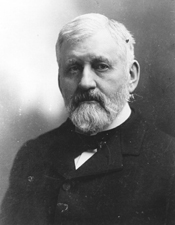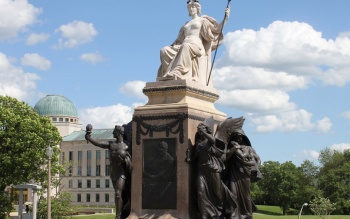Encyclopedia Dubuque
"Encyclopedia Dubuque is the online authority for all things Dubuque, written by the people who know the city best.”
Marshall Cohen—researcher and producer, CNN
Affiliated with the Local History Network of the State Historical Society of Iowa, and the Iowa Museum Association.
ALLISON, William Boyd
Family History: http://wc.rootsweb.ancestry.com/cgi-bin/igm.cgi?op=GET&db=jkhouser84&id=I58262
ALLISON, William Boyd. (Perry, Wayne County, OH, Mar. 2, 1829-Dubuque, IA, Aug. 4, 1908). Despite helping to establish the Ohio Republican Party, Allison lost a campaign for prosecuting attorney for Ashland County in 1856. (1) He moved to Dubuque in 1857, joined a local law partnership, and with membership in a Presbyterian church rose to leadership in the young Republican Party in the state. In 1859 he was chosen a delegate to the Republican State Convention. (2)
In 1860 at the Republican National Convention, Allison, a young delegate and state convention secretary from Iowa, was the first to tabulate the roll and inform the convention president that Abraham Lincoln had obtained enough votes to secure his party's nomination for President of the United States. (3)
The 1860 Census led Iowa's congressional delegation to increase from two to six. Allison used his political and business connections including Governor Kirkwood and railroad builder Grenville M. Dodge to win the Republican nomination. Although Allison did not receive the political appointments he desired, Governor Samuel J. Kirkwood in 1861 appointed him to be one of his military aides during the CIVIL WAR. In this role, Allison proved to be a good manager of the transportation, organization, and medical needs of Iowa volunteers enlisting in the Dubuque area. (4)
Dennis MAHONY was his opponent in 1862 during a campaign in which Allison declared Mahony to be a traitor to the republic. (5) Allison lost Democratic Dubuque in that election but won the general election to the United States House from Iowa's Third District. (6) He went on to serve four terms from 1863-1871. (7)
Allison quickly joined the ranks of the Radical Republicans and opposed Lincoln's plans for Reconstruction. (8) During the first two years he was a member of Congress, Allison introduced a bill for improving the navigation of the MISSISSIPPI RIVER. It was through his influence that the land grant was secured for the railroad leading westward to McGregor, Iowa. While in Congress, Allison supported every Republican measure including the Civil Rights Bill and the Freedman's Bureau Bill. (9)
In his second term, Allison became a member of the powerful Ways and Means Committee. He gained a reputation for his knowledge of tariffs and railroads and as a supporter of moderate tariffs that benefited agriculture. While not known as a great orator or thinker, he was considered a party loyalist who was also sensitive to party leaders, party factions and the electorate in Iowa. (10) For example, he assisted Charles Aldrich obtain specimens of birds, Native American artifacts, and an important collection of southwestern American Indian pottery from the Smithsonian Institution and the Bureau of Ethnology for the Iowa museum collections in the 1890s. He also helped obtain collections of guns from the Rock Island Arsenal. (11)
Allison had the political backing of Iowa Senator Grimes who was retiring, but unfortunately did not, in this case, have the backing of Senator James Harlan's supporters who backed James B. Howell in the election. In 1871, Allison lost his campaign to become an Iowa senator.
Allison returned briefly to his legal practice in Dubuque. In 1872, his political alliances, however, led to him winning the Republican caucus nomination to the United States Senate. This guaranteed his election in the Republican-controlled Iowa Legislature--by one vote. (12) He went on to serve as a U. S. senator from Iowa for six terms (1873-1908) and as the Senate majority leader in 1897 and 1904 until his death. Allison's political alliances and his position in the United States Senate led him to be the center of the "Des Moines Regency." This small group including James Clarkson of the Iowa State Register, Charles E. Perkins and Joseph W. Blythe of the Burlington Railroad had tremendous influence in the state on county, district, and state conventions after 1873. (13)
Allison played a small role in preserving the nation's capital in Washington, D.C. The war years had left the capital in terrible condition and political leaders seriously considered moving business to another city. Prominent business people raced to repair and renovate the city. Streets were improved and with the spread of water and gas lines and more street lights new residential areas developed. Mansions were constructed where Vermont and Rhode Island avenues met and a large park was called "Iowa Circle" by Senator Allison. The site was renamed Logan Circle in 1930 in memory of John Logan, a founder of Memorial Day. (14)

Known as the "Gibraltar of Iowa Democracy" and "Mr. Republican" for nearly two decades, Allison, the senior Republican member on the Committee on Appropriations, was the single most powerful Congressional voice on all decisions involving finances. He gained less obvious power from his membership in "The Senate Four" (with Nelson Aldrich of Rhode Island, John C. Spooner of Wisconsin, and Orville H. Platt of Connecticut), all members of the Committee on Finance who dominated Congress. (15) Senator Albert Beveridge described the four as a “marvelous combination” of Aldrich as manager, Allison as conciliator, Spooner as debater, and Platt as builder." (16) Allison was also a member of the Committee on Committees, chairman of the Republican caucus, and chairman of the steering committee.
In 1874 Allison worked with local supporters to convince the War Department to give the city of Dubuque a 25-pound parrot gun with carriage. The Dubuque Herald editorial staff commented that now the city could properly salute patriotic events. (17)
In 1875 Allison was one of the commissioners appointed to negotiate with the SIOUX for the sale of the Black Hills. The unsuccessful venture failed to stop white trespassing on sacred Native American land and led to the massacre of General Custer at Little Big Horn.
Allison found in the Senate nearly his only pleasure in life. Yet after 43 years in Congress only one piece of legislation bears his name, the Bland-Allison Act of 1878 which was intended to buy a certain amount of silver and put it into circulation as silver dollars. (18) Two other highly important pieces of legislation to which he made vital contributions were the Senate Report advocating a commission form of government for the District of Columbia, containing the idea for the now-familiar commission type of municipal government, and the Railroad Rate Act of 1906. (19)
Allison was twice (1888, 1896) a contender for the Republican presidential nomination. (20) In 1888 the Republican convention in Chicago had a slate of eighteen contenders for its nomination and it took eight ballots to decide. Allison peaked on the sixth ballot with 99 votes, but then tapered off with 73-76 and 0; the winner was Benjamin Harrison. (21) On November 12, 1895 Allison was accompanied on a campaign trip to Chicago by powerful David Bemer HENDERSON. Efforts were being made at the time to convince General McAlpin of New York and newly elected president of the National League of Republican Clubs to run under Allison as vice-president. (22) The nomination eventually went to William McKinley who won the election against William Jennings Bryan.
Held in high esteem by others in governmental service, Allison was offered cabinet positions by presidents Garfield, Harrison and McKinley. (23) In 1892 he was appointed chairman of the International Monetary Conference at Brussels, Belgium. (24) In 1896 President McKinley asked him to be secretary of state. The Des Moines Leader stated at the time that the "opinion of Iowa people is fast settling on the belief that Senator Allison will be the next Secretary of State." (25) The paper went on to state that "those who know Senator Allison best are most convinced that he is planning to accept the place." (26)
Allison declined the position believing he could do more for the country as chairman of the powerful Senate Appropriations Committee. (27) President McKinley again asked Allison to join his cabinet in 1900 upon the death of Vice President Garret Hobart. Allison again declined for the same reason. McKinley then chose Theodore Roosevelt who assumed the presidency after McKinley was assassinated on September 9, 1901.
By 1907 the eighty-year-old senator was suffering from cancer and left the campaigning for renomination to his friend and colleague, Senator Jonathan P. Dolliver. He won the campaign in June but died at his Dubuque home in August. (28) President Theodore Roosevelt sent Vice-President Fairbanks to the funeral. (29)
In 1917, friends of Senator William B. Allison, citizens and school children of Iowa, and the state legislature raised a memorial to Allison in Des Moines. The monument was designed by Evelyn B. Longman of New York. A central plaque picturing Allison is flanked by symbols of "Knowledge" on the left and "Peace" on the right. The former is followed by "Legislature" and "Financial Prosperity," the latter by "Humanity" and "Agricultural Prosperity." The topmost figure is "The Republic." (30)
Said to be so cautious as a politician "that he could walk on eggs from Des Moines to Washington without breaking one of them," Allison will be remembered as strongly supporting business, industrial, and railroad interests, promoting a "hard-money" currency program, and crafting high protective tariffs. (31) In 2016 Allison's record of chairing the Senate Appropriations Committee for twenty-five years stood as the record for longest-serving chairman of a standing committee. (32)
A little known feature of Allison's life was his role in local baseball. Ted Sullivan, one of the game’s foremost organizers, formed and ran the Northwest League which consisted of clubs from Illinois, Davenport, Omaha, and Rockford, and Dubuque, Iowa. It was the first so called minor league formed outside the east coast. Sullivan took steps to set a salary structure for the Northwest League which to some establishes it as the first legitimate minor league. Sullivan ran the Dubuque team which was financed by Allison and future congressman and Speaker of the House David B. HENDERSON. (33)
---
Sources:
1. Hudson, David; Bergman, Marvin; Horton, Loren. The Biographical Dictionary of Iowa. Iowa City: University of Iowa Press, 2008 p. 14
2. Ibid.
3. Pregler, John T. "Area's Political History Star-Crossed," Telegraph Herald, Oct. 28, 2012, p. 11A
4. Tigges, John. They Came From Dubuque, Dubuque, Iowa: Kendall/Hunt Publishing Company, "Allison and Henderson" by Rose M. Onufrak, 1983, p. 45
5. Meyer, Jeffrey L. "A Presidential Future That Never Was," Julien's Journal, February 2011, p. 45.
6. Ibid.
7. Hudson, p. 14
8. Ibid.
9. Oldt, Franklin T. History of Dubuque County, Iowa. Chicago: Western Historical Company, 1880, p. 761
10. Hudson, p. 15
11. Hudson, p. 7
12. Hudson, p. 15
13. Ibid.
14. Sign outside the Mary McLeod Bethune National Historic Site in Washington, D. C.
15. Sage, Leland. Two Gentlemen of Dubuque.Online: http://www.lib.uiowa.edu/spec-coll/Bai/sage.htm
16. "The Senate Four," The United States Senate. Online: https://www.senate.gov/artandhistory/history/common/generic/People_SenateFour.htm
17. "Now We Can Salute," Dubuque Herald, July 23, 1874, p. 4. Online: https://news.google.com/newspapers?nid=uh8FjILnQOkC&dat=18740723&printsec=frontpage&hl=en
18. Bland-Allison Act. http://www.u-s-history.com/pages/h718.html
19. Hudson, p. 15
20. "William Boyd Allison," The Biographical Dictionary of Iowa, Online: http://uipress.lib.uiowa.edu/bdi/DetailsPage.aspx?id=11
21. "The Republican Convention of 1888," Wipipedia. Online: https://en.wikipedia.org/wiki/1888_Republican_National_Convention
22. "Boom for Allison," Dubuque Daily Herald, November 13, 1895, p. 4
23. William Boyd Allison. Online: bioguide.congress.gov/scripts/biodisplay.pl?index=a000160
24. Meyer, p. 46
25. "About Allison," Dubuque Herald, December 14, 1896, p. 4
26. Ibid.
27. "Has Declined," Dubuque Herald, January 7, 1897, p. 4
28. Hudson, p. 16
29. Meyer, p. 47
30. William Boyd Allison Monument. Online:http://dsmpublicartfoundation.org/public-art/us-senator- william-boyd-allison-monument/
31. Linwood Legacies: A Historical Series. Online: http://www.linwoodlegacies.org/william-boyd-allison.html
32. "States in the Senate," Online: http://www.senate.gov/states/IA/intro.htm
33. McKenna, Brian. "Old Hoss" Radbourne. Society for American Baseball Research. SABR Baseball Biography Project, Online: http://sabr.org/bioproj/person/83bf739e












